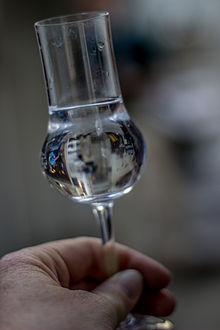| This article needs additional citations for verification. Please help improve this article by adding citations to reliable sources. Unsourced material may be challenged and removed. Find sources: "Eau de vie" – news · newspapers · books · scholar · JSTOR (March 2008) (Learn how and when to remove this message) |

An eau de vie (French for spirit, lit. 'water of life') is a clear, colourless fruit brandy that is produced by means of fermentation and double distillation. The fruit flavor is typically very light.
In English-speaking countries, eau de vie refers to a distilled beverage made from fruit other than grapes. Similar terms may be local translations or may specify the fruit used to produce it. Although eau de vie is a French term, similar beverages are produced in other countries (e.g., German Schnaps, Greek ούζο, Turkish rakı, Balkan rakia, Romanian țuică, Czech and Slovak pálenka, Hungarian pálinka, and Sri Lankan coconut arrack). In French, however, eau de vie is a generic term for distilled spirits. The proper French term for fruit brandy is eau-de-vie de fruit, while eau-de-vie de vin means wine spirit (brandy), and several further categories of spirits (distilled from grape pomace, lees of wine, beer, cereals, etc.) are also legally defined as eau-de-vie in a similar fashion. Many eaux de vie made from fruits, wine, pomace, or rye have a protected designation of origin within the European Union.
Production
Fruit spirit
Main article: Fruit brandyTraditional fruit spirits are made with ripe fruit that is fermented, distilled, and quickly bottled to preserve the freshness and aroma of the parent fruit. Eaux de vie are typically not aged in wooden casks, hence they are clear. Although this is the usual practice, some distillers age their products before bottling.
Geist
Main article: Geist (liquor)Some fruits, such as raspberries, rowanberries, rosehips, and sloes, do not contain adequate sugars for fermenting. Instead, the spirits are produced by macerating fruit in neutral grain spirits for some time before distilling. The legal term used for these spirits within the European Union is Geist, meaning "spirit" in German. Geist can also be produced with vegetables, nuts, herbs, and other plant materials such as rose petals, mushrooms or pumpkin seeds.
Varieties
Most commonly available flavors in France are eau de vie de poire (pear, known as eau de vie de Poire Williams when made from the Williams pear), eau de vie de framboise (raspberries), eau de vie de pomme (apple), eau de vie de mirabelle (mirabelle plum), and eau de vie de pêche (peach). When made from pomace, it is called pomace brandy or marc.
While most eaux de vie from the Alpine regions of Europe only rest very briefly in glass containers, others are aged in wooden casks before bottling. Thus, calvados, an apple-based spirit from northwestern France, is required by law to spend at least two years in wood, and most producers also offer much older products to the market (up to 20 years or more). Some slivovitz are also aged in wooden casks, giving them their golden or amber color and some additional flavors. Romanian țuică bătrână is aged in casks made from mulberry wood, which impart a pale brown color.
In the Caribbean, eaux-de-vie are made from tropical fruits such as banana, ambarella, guava, mango, pineapple, and sapodilla.
The term can also refer to maple eau de vie, made from maple syrup.
Acerum is a Canadian eau de vie made in Quebec from maple syrup.
Serving

An eau de vie is usually served as a digestif. The typical serving size is 30 to 60 ml (1.1 to 2.1 imp fl oz; 1.0 to 2.0 US fl oz), owing to the high alcohol content of the spirit and because it is typically drunk after a meal during which wine, or some other alcoholic beverage, has already been served.
Sometimes, also is used in traditional recipes of the French cuisine, for deglazing, instead of – or together with – the usual white wine.
Eaux de vie should be served cold.
See also
- Akvavit
- Aqua vitae
- Aguardiente
- Brandy
- Chacha
- Damassine
- Grappa
- Kirsch
- Liquor
- Orujo
- Pálinka
- Rakia
- Schnapps
- St. George Spirits – an American producer of eau de vie
- Țuică
- Williamine
Explanatory notes
- English: /oʊdəˈviː/; French: [odəvi]. Plural: eaux de vie. The phrase can also be hyphenated eau-de-vie and eaux-de-vie
References
- ^ Regulation (EU) No 110/2008 of 15 January 2008 on the definition, description, presentation, labelling and the protection of geographical indications of spirit drinks and repealing Council Regulation (EEC) No 1576/89 §16, §17
- Asimov, Eric (15 August 2007). "An Orchard in a Bottle, at 80 Proof". The New York Times. Retrieved 21 July 2007.
But his first love are the gorgeous, impeccably pure eaux de vie that he makes from pears and plums, cherries and raspberries, and even, in a distinctly Northwestern touch, from the springtime buds of Douglas firs.
- Apple, R. W. Jr. (April 1998). "EAU de Vie: Fruit's Essence Captured in a Bottle". The New York Times.
- "Beim Schnapsbrenner in Spalt: Destillierte Heimat" [At the Schnaps Maker in Spalt: Distilled Homeland]. Bayerischer Rundfunk (in German). 2 March 2019. Retrieved 21 November 2021.
- "Alcools à base d'érable: un marché en pleine effervescence". LaTerre (in French). 22 December 2018. Retrieved 25 July 2022.
- Prial, Frank J. (18 February 1979). "Fruits of the Distiller's Art". The New York Times. Retrieved 21 November 2021.
External links
- Buying guide from Food & Wine
| Alcoholic beverages | |||||||||||
|---|---|---|---|---|---|---|---|---|---|---|---|
| |||||||||||
| |||||||||||
| |||||||||||
| |||||||||||